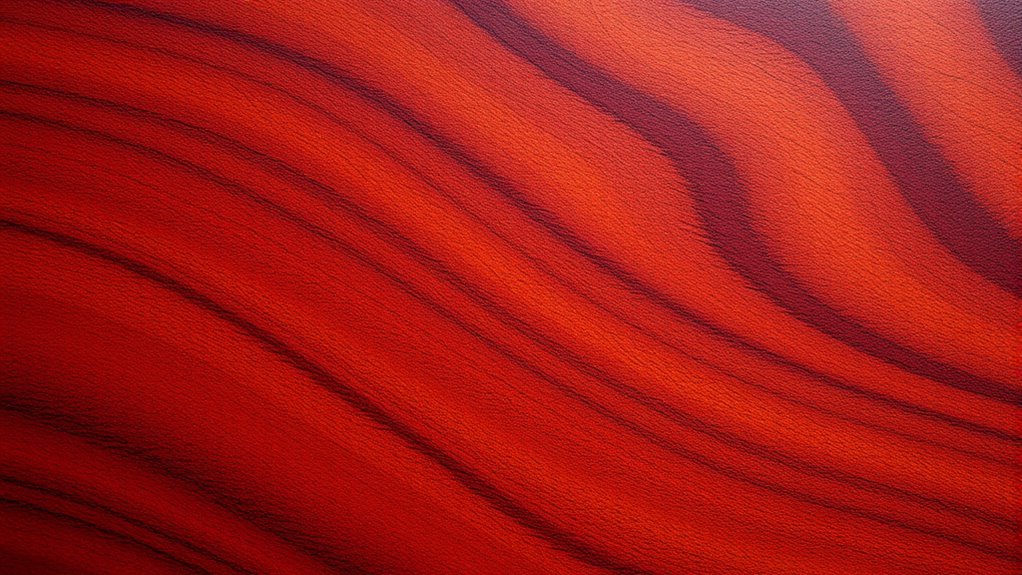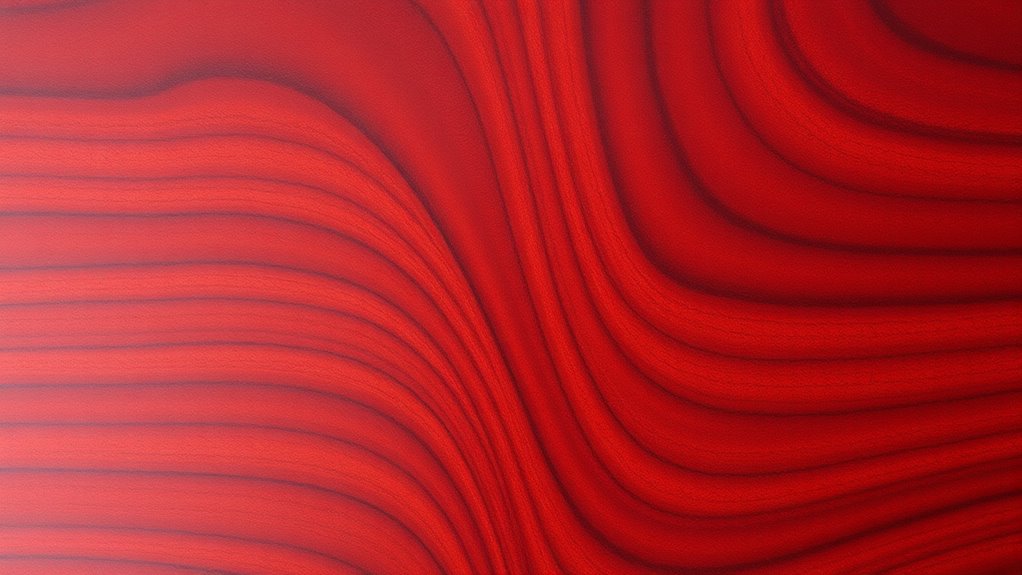To spot mahogany, look for its distinctive ribbon-like, straight grain that creates a smooth, flowing pattern. It usually has a warm reddish-brown color, deepening with a lustrous patina over time, with subtle streaks blending seamlessly. Feel its fine, polished surface for a sleek, dense texture that’s consistent and smooth. Focus on these identifying features to confidently recognize mahogany’s unique appearance, and explore further details to become more familiar with its characteristics.
Key Takeaways
- Look for a rich, warm reddish-brown color with subtle streaks and a consistent hue.
- Identify straight or ribbon-like grain patterns that flow smoothly across the surface.
- Feel for a smooth, fine, polished texture with a sleek surface.
- Observe how light reflects softly to highlight the flowing grain pattern.
- Confirm dense, tight grain structure with uniform coloration for authentic mahogany.

Have you ever wondered how to identify genuine mahogany among other woods? It’s a question that often puzzles woodworkers and collectors alike. The key to spotting real mahogany lies in paying close attention to its unique grain pattern and coloration differences. When you examine a piece of mahogany, you’ll notice that its grain pattern is typically straight, but it can sometimes display a ribbon-like or interwoven appearance. The ribbon grain creates a smooth, flowing look that’s quite distinctive from other hardwoods. The lines appear as narrow, wavy strips that run parallel along the length of the wood, giving it a sense of depth and richness. This pattern is a hallmark of true mahogany and helps you distinguish it from similar woods like cherry or walnut, which tend to have more irregular or varied grain patterns. The grain pattern is often highlighted by the way light reflects off the smooth surface, emphasizing the flowing lines.
Coloration differences are another essential factor. Genuine mahogany usually displays a rich, warm hue that ranges from medium to dark reddish-brown. Over time, it may develop a deeper, more lustrous patina, but its base color remains within this warm spectrum. When you compare it to other woods, mahogany’s color tends to be more uniform, with subtle variations that highlight its natural beauty. Some pieces might have slightly lighter or darker streaks, but these are generally soft and blend seamlessly into the overall tone. Keep an eye out for a consistent coloration that reflects the wood’s high-quality, dense nature.
In addition to grain pattern and coloration, the texture of mahogany is another giveaway. It’s usually smooth to the touch, with a fine, even surface that feels sleek and polished. When you run your hand over it, you’ll notice a subtle resistance that indicates a tight, closed grain structure. This density contributes to its durability and makes it ideal for fine furniture and detailed woodworking projects. The combination of its straight or ribbon-like grain, warm coloration, and smooth texture makes mahogany stand out from other woods, which might have more irregular grain, inconsistent color, or a rougher feel.
Frequently Asked Questions
How Can I Distinguish Genuine Mahogany From Imitators?
To distinguish genuine mahogany from imitators, start by checking its wood scent, which is distinctly rich and warm. Feel the weight—mahogany is dense and feels heavier than fake versions made from lighter woods. Examine the grain; authentic mahogany has a fine, even ribbon grain pattern. If you’re unsure, compare it to a known piece or consult a professional to verify you’re getting real mahogany.
What Tools Are Best for Analyzing Mahogany’s Grain?
You should use a magnifying glass or a jewelers’ loupe to examine mahogany’s grain pattern closely. These tools help you see the fine ribbon grain and assess color consistency, which are key indicators of genuine mahogany. A good light source, like a portable LED flashlight, also helps reveal subtle details in the grain and color. Combining these tools allows you to confidently analyze the authenticity of the wood.
Does Mahogany’s Appearance Vary With Its Origin?
You’ll find that mahogany’s appearance does vary with its origin, especially in wood grain and color variation. For example, Honduran mahogany is prized for its rich, deep red hue and fine grain, while African mahogany tends to have a more uniform, lighter color. About 75% of woodworkers notice these differences, making it important to take into account the source when selecting mahogany for your project.
How Does Aging Affect Mahogany’s Color and Texture?
Aging effects on mahogany deepen its color, giving it a richer, more lustrous hue over time. You’ll notice a surface patina that adds character and a smooth, refined texture. As it ages, the wood develops a subtle glow, enhancing its natural beauty. This process highlights the grain and adds to its vintage appeal, making aged mahogany a sought-after choice for high-quality furniture and fine craftsmanship.
Are There Common Mistakes to Avoid When Identifying Mahogany?
Did you know that about 40% of mahogany sold today is mislabeled? When identifying mahogany, avoid common mistakes like relying solely on color, which can vary with age and finishing, or ignoring the grain pattern, which should be consistent and ribbon-like. Always check for uniformity in color and grain, and be cautious of wood that looks too perfect or has inconsistent texture, as these may indicate fakes or other species.
Conclusion
By understanding mahogany’s rich color, smooth texture, and distinctive ribbon grain, you can truly appreciate its character. Think of mahogany as a timeless tapestry, each stripe and hue weaving a story of elegance and warmth. When you spot these features, you’re holding a piece of nature’s artistry. So, embrace the beauty of mahogany, and let its mesmerizing qualities inspire your craft or decor—like a treasured jewel waiting to be discovered.









